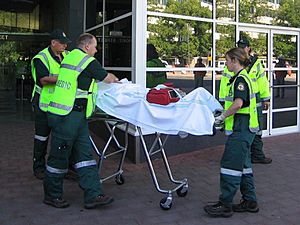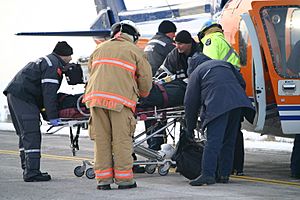Paramedic facts for kids

Paramedics of the Australian Capital Territory Ambulance Service during training
|
|
Quick facts for kids Occupation |
|
|---|---|
| Names | Paramedic |
| Profession | |
|
Activity sectors
|
Health care |
| Description | |
|
Fields of
employment |
Ambulance; Hospital; Pre-Hospital; Transport |
|
Related jobs
|
Emergency medical technician |
A paramedic is a special healthcare professional. Their main job is to help people who have medical emergencies outside of a hospital. Paramedics usually work in ambulances as part of the emergency medical services (EMS). They are trained to make quick decisions about how to care for patients in urgent situations.
Not everyone who works in an ambulance is a paramedic. In some countries, paramedics have more training and can do more things than emergency medical technicians (EMTs).
Contents
What do paramedics do?
Paramedics have a very important job. They help people with serious injuries or illnesses. Their main goal is to make patients stable and then take them to a hospital. This is where patients can get more advanced care.
Paramedics work in many different places. You might see them on roads, in people's homes, or even in wild areas. Some paramedics also work in hospitals, on aircraft, or with special police teams. They don't just handle emergencies. Sometimes, they help people who are chronically ill. They might take them to appointments or even visit them at home. This is called community paramedicine.
The way paramedics work can be different around the world. In some countries, paramedics make many decisions on their own. In others, they work closely with doctors who are also at the scene. For example, in places like the United Kingdom, paramedics are independent health professionals. In other places, like France, doctors lead the ambulance care.
Over time, the job of a paramedic has changed a lot. It used to be mostly about taking patients to the hospital. Now, paramedics can often give advanced treatments right where the emergency happens. In some cases, they can even help people avoid going to the hospital entirely. They might be able to give certain medicines or send patients directly to a specialist.
What are the dangers of being a paramedic?
Paramedics face many risks in their job. They often have to lift heavy patients and equipment. They might treat people with infectious diseases. They also deal with dangerous substances. Traveling in ambulances or helicopters can also be risky.
Employers try to keep paramedics safe. They provide special equipment to help lift patients. They also train paramedics about job dangers. Paramedics wear protective gear like masks, gloves, and gowns. This helps protect them from germs.
During the COVID-19 pandemic, infectious diseases became a big worry. Health organizations gave advice to keep paramedics safe. This included asking questions about symptoms before arriving. It also meant always wearing protective gear and washing hands often. Keeping a safe distance from others was also important. Cleaning ambulances very well after each patient was also a key step.
Research has shown that air in ambulances can spread germs. This is why good ventilation systems are important. They help protect paramedics when they transport sick patients.
What skills do paramedics use?
Paramedics learn many important skills. These skills help them save lives and care for patients. Here are some common things paramedics can do:
Life-saving skills
- Advanced cardiac life support: This includes helping someone whose heart has stopped. They can do cardiopulmonary resuscitation (CPR). They can also use a defibrillator to shock the heart.
- Patient assessment: They check a patient's vital signs (like heart rate and breathing). They also do a physical exam and ask about their health history. They can use special machines to check heart activity and oxygen levels.
- Airway management: They make sure patients can breathe. This might involve putting a tube into the windpipe. They can also clear blocked airways.
- Treating serious injuries: They can help with collapsed lungs or fluid around the heart.
- Giving medicine: They can put needles into veins or bones to give fluids or medicines.
- Oxygen and breathing support: They can give oxygen and help patients breathe using special masks or machines.
- Controlling bleeding: They know how to stop serious bleeding and treat shock.
- Spinal injury care: They can carefully move and secure patients with possible back or neck injuries.
- Broken bone care: They can check for fractures and use splints to support broken bones.
- Childbirth: They can help deliver babies and handle problems during birth.
- Burn treatment: They can assess and treat different types of burns.
- Triage: In big emergencies with many injured people, they decide who needs help first.
- Advanced procedures: Some paramedics can perform more complex procedures if they have extra training. This might include field amputations in extreme situations.
Emergency medicines
Paramedics carry many different medicines. They can give these medicines in emergencies. The exact medicines they are allowed to use depend on where they work. Each area has its own rules and guidelines. If you want to know about specific medicines, you would need to check with the local health authorities.
How do paramedics get their authority?
The rules for paramedics are different depending on the country or region.

In many places, paramedics work under the direction of a doctor. This doctor gives them permission to do certain medical procedures. For example, in the United States, a doctor gives paramedics the authority to practice. This means paramedics follow specific rules and guidelines. They also get advice from doctors over the phone or radio. This allows them to act like "field agents" for emergency doctors. They can make important decisions on their own.
In other places, paramedics are recognized as independent healthcare professionals. They are registered with a special group. This group makes sure paramedics follow all the rules for their profession. They can give prescription medications and are responsible for their own actions. For example, in the United Kingdom, the Health and Care Professions Council oversees paramedics. They can take action if a paramedic does not follow the rules.
Some paramedics get even more training. They become "paramedic practitioners" or "advanced paramedics." This allows them to use more skills and give a wider range of medicines.
In some areas, paramedics can only do advanced skills if a doctor is physically there. However, they can still perform life-saving actions in very urgent situations.
Paramedics in movies and TV shows
Paramedics have been shown in many popular movies and TV shows. These shows often inspire people to become paramedics. They also help people understand what paramedics do.
- Emergency! was a very popular TV show in the 1970s. It showed the work of paramedics in Los Angeles. This show helped many cities start their own paramedic programs.
- Mother, Jugs & Speed (1976) was a comedy film about a private ambulance company.
- Casualty is a long-running British TV show (since 1986). It shows the work of paramedics and hospital staff.
- Bringing Out the Dead (1999) is a drama film starring Nicolas Cage. It shows the tough life of a paramedic in New York City.
- Third Watch (1999–2005) was an American TV drama. It focused on firefighters and paramedics in New York City.
- Code Blue: Doctor-Heli (2008, 2010) is a Japanese TV drama about flight doctors and paramedics.
- Trauma (2009–10) was an American TV series about San Francisco paramedics.
- Junior Paramedics (2014) is a British TV series. It follows new paramedics during their training.
- Boston EMS (2015) is a documentary series. It shows the work of first responders in Boston, Massachusetts.
- Ambulance (2016) is a BBC documentary. It follows paramedics in different parts of the UK.
Images for kids
Error: no page names specified (help). In Spanish: Paramédico para niños
In Spanish: Paramédico para niños


